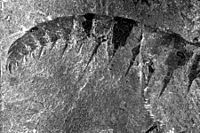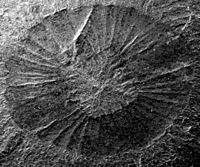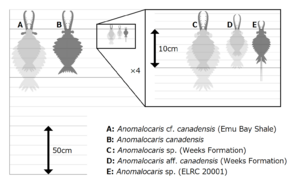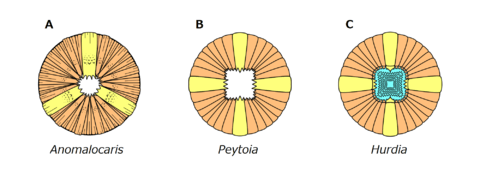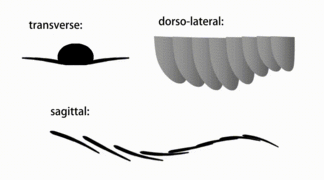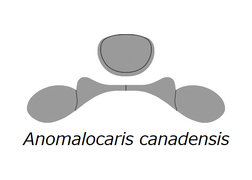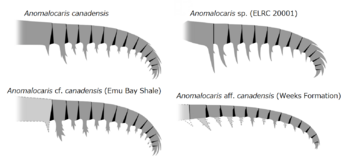Anomalocaris facts for kids
Quick facts for kids Anomalocaris |
|
|---|---|
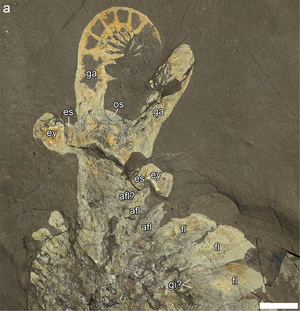 |
|
| ROMIP 51212, a largely complete specimen of Anomalocaris canadensis. | |
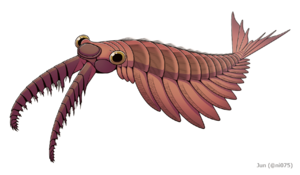 |
|
| Life restoration of Anomalocaris canadensis. | |
| Scientific classification |
|
| Unrecognized taxon (fix): | Anomalocaris |
| Species | |
(8 more unnamed species) |
|
Anomalocaris ("unlike other shrimp", or "abnormal shrimp") is an extinct genus of radiodont, an order of early-diverging stem-group arthropods.
It is best known from the type species A. canadensis, found in the Stephen Formation (particularly the Burgess Shale) of British Columbia, Canada. The species A. daleyae is known from the somewhat older Emu Bay Shale of Australia. Other remains are known from China and the United States. Originally, several fossilized parts discovered separately (the mouth, frontal appendages and trunk) were thought to be three separate creatures, a misapprehension corrected by Harry B. Whittington and Derek Briggs in a 1985 journal article.
Like other radiodonts, Anomalocaris had swimming flaps running along its body, large compound eyes, and a single pair of segmented, "frontal appendages", which in Anomalocaris were used to grasp prey. Measuring up to 38 cm (1.25 ft) long excluding frontal appendages and tail fan, A. canadensis is one of the largest animals of the Cambrian, and thought to be one of the earliest examples of an apex predator, though others have been found in older Cambrian lagerstätten deposits.
Discovery and identification
From the start, Anomalocaris fossil was misidentified.
1886-1888: The first Anomalocaris fossils were collected by Richard G. McConnell of the Geological Survey of Canada in the Ogygopsis Shale
1892: The specimens were described and named by GSC paleontologist Joseph Frederick Whiteaves, who initially thought the mouth, frontal appendages, and trunk were three separate creatures.
1911: Charles Doolittle Walcott discovered the first fossilized mouth of a similar animal, which he mistakenly placed in the genus Peytoia, thinking it was a jellyfish.
1928: Danish paleontologist Kai Henriksen attached Anomalocaris to the carapace of Tuzoia, but Briggs suggested instead that it was the appendage of an unknown arthropod, which turned out to be correct.
1978: Simon Conway Morris re-examined a full-body anomalocaridid specimen that was originally described as the sea cucumber Laggania cambria, and concluded that it was a superimposition of the "jellyfish" Peytoia nathorsti on top of a sponge.
1980s: Harry B. Whittington, while preparing an unidentified Burgess Shale fossil, uncovered two Anomalocaris "shrimp" attached to the head region of a large body, which also had the "jellyfish" Peytoia as the mouth apparatus. This discovery confirmed the true identity of Anomalocaris.
In 2011 and 2020, compound eyes of Anomalocaris were recovered from a paleontological dig at Emu Bay on Kangaroo Island, Australia, proving that Anomalocaris was indeed an arthropod as had been suspected. The find also indicated that advanced arthropod eyes had evolved very early, before the evolution of jointed legs or hardened exoskeletons.
Description
For the time in which it lived, Anomalocaris was gigantic. It could grow up to 37.8 cm (1.24 ft) long excluding frontal appendages and tail fans.
It had a wide, segmented body with 14 podomeres or segments. The widest part of its body was between the third and fifth lobe, gradually narrowing towards the tail
Anomalocaris had a pair of large compound eyes on both sides of its head.
It had an unusually large, disk-like mouth consisting of 32 overlapping plates. This mouth structure is known as an oral cone, and it was composed of several plates organized triradially. The plates gave the head of Anomalocaris the appearance of a pineapple ring.
Anomalocaris had powerful frontal appendages with sharp spikes on each segment, which it likely used to grab its prey. The species swam using rows of undulating overlapping lobes (flexible flaps) on the sides of its body, which formed a single fin and allowed it to propel itself fast through the water. It had a large fan-shaped tail, which the animal probably used for propulsion.
Diet
The diet of Anomalocaris has been a subject of debate among scientists. Some believe it was a powerful predator that could crush trilobites and other hard-shelled prey with its mouth. However, others argue that its mouth and teeth were too soft for such a diet, and it likely fed on softer items like worms, microorganisms, and plankton. It could have consumed very small trilobites and recently molted trilobites whose new shells had not yet hardened, but the vast majority of trilobites would have been too hard for Anomalocaris to eat. There is no clear evidence in the fossil record of Anomalocaris eating hard-shelled prey.
Habitat
Anomalocaris is believed to have had a worldwide distribution, with fossils found in various locations, including Australia, Canada, China, Greenland, and the USA. The species adapted well to a vast range of environments.
Anomalocaris primarily lived in the ocean, which made up around 85% of the Earth during the Cambrian period, compared to approximately 70% today. The species is thought to have inhabited both shallow and deep waters up to 1,000 meters, with its well-developed eyes suggesting a preference for deeper, darker environments.
See also
 In Spanish: Anomalocaris para niños
In Spanish: Anomalocaris para niños
- 8564 Anomalocaris, an asteroid named after this animal.
- Radiodonta, extinct arthropod order composed of Anomalocaris and its relatives.
- Houcaris, Lenisicaris, Innovatiocaris, Guanshancaris, Echidnacaris, radiodont genera containing species originally named as Anomalocaris.
- Aegirocassis, a giant filter-feeding radiodont from Ordovician Morocco.
- Cambrian explosion, the large bio-diversification event that occurred during the Cambrian.
- Opabinia, a genus of bizarre stem-group arthropod distantly related to the radiodonts.
- Wiwaxia, a genus of possible mollusk that had copious numbers of carbonaceous scales, and lived alongside Anomalocaris.
- Paleobiota of the Burgess Shale


